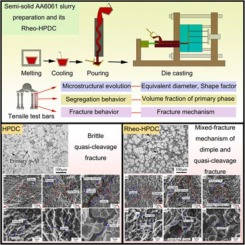반고체 또는 전통적인 고압 다이 캐스팅으로 형성된 6061 알루미늄 합금 샘플의 미세 구조, 분리 및 파괴 거동
NaiyongLiWeiminMaoXiaoxinGengRongshengZhangBingdongYan
Highlights
•Semi-solid 6061 aluminum alloy slurry prepared by the SCP process.
•Rheo-HPDC can improve and refine the coarse dendritic microstructures in the traditional HPDC samples.
•Segregation is improved by increasing the Si content in the alloy.
•The residual liquid during the secondary solidification obeys the Mullins−Sekerka instability theory.
Abstract
A serpentine channel pouring (SCP) process for efficiently preparing semi-solid 6061 aluminum alloy slurry and its rheological high pressure die casting (Rheo-HPDC) technology were introduced. The microstructure, segregation and fracture behavior of 6061 aluminum alloy samples obtained via the traditional HPDC or Rheo-HPDC process were investigated and compared.
Furthermore, the effects of pouring temperature and Si content on the distribution, grain size and volume fraction of the primary phase were analyzed. The results indicated that the Rheo-HPDC process can effectively refine and improve the morphology of the primary phase compared with the traditional HPDC samples, which evolved from coarse dendrites into fine spherical grains.
The pouring temperature had a significant effect on the primary α1-Al grains during slurry preparation, but had little effect on the secondary solidified α2-Al grains in the Rheo-HPDC samples. Moreover, with increasing Si content, the casting capability of the alloy was significantly enhanced, while the grain size of the primary phase was no obviously changed. Additionally, the liquid segregation led to varying microstructures, elemental distributions and fracture mechanisms of the samples.
The volume fraction of the primary phase increased with increasing the distance from the sample surface, while the Si, Mg, Fe and Cu contents were enriched at edge of the testing bars. Besides, the liquid segregation tendency gradually increased along the filling direction in the Rheo-HPDC samples. Under the same die casting process parameters, the Rheo-HPDC samples had excellent mechanical properties than that of the traditional HPDC samples, and its ultimate tensile strength (UTS) increased from 90.8 MPa to 106.9 MPa.
The fracture mechanism of the traditional HPDC samples was mainly brittle quasi-cleavage fracture, while the Rheo-HPDC samples was mainly mixed-fracture mechanism of dimple and quasi-cleavage fracture.
반고체 6061 알루미늄 합금 슬러리를 효율적으로 준비하기 위한 구불구불한 채널 주입(SCP) 공정과 유변학적 고압 다이캐스팅(Rheo-HPDC) 기술이 도입되었습니다. 기존 HPDC 또는 Rheo-HPDC 공정을 통해 얻은 6061 알루미늄 합금 샘플의 미세 구조, 분리 및 파괴 거동을 조사하고 비교했습니다.
또한, 주상의 분포, 입자 크기 및 부피 분율에 대한 주입 온도 및 Si 함량의 영향을 분석하였다. 결과는 Rheo-HPDC 공정이 거친 수상돌에서 미세한 구형 입자로 진화한 기존의 HPDC 샘플과 비교하여 1차상의 형태를 효과적으로 개선하고 개선할 수 있음을 나타냅니다.
주입 온도는 슬러리 준비 동안 1차 α1-Al 입자에 상당한 영향을 미쳤지만 Rheo-HPDC 샘플에서 2차 응고된 α2-Al 입자에는 거의 영향을 미치지 않았습니다. 또한, Si 함량이 증가함에 따라 합금의 주조 능력이 크게 향상되었지만 1차상의 입자 크기는 분명히 변경되지 않았습니다.
또한 액체 분리로 인해 샘플의 미세 구조, 원소 분포 및 파괴 메커니즘이 다양해졌습니다. 1차상의 부피 분율은 시료 표면에서 멀어질수록 증가하는 반면, Si, Mg, Fe 및 Cu 함량은 테스트 막대의 가장자리에서 풍부합니다. 게다가, 액체 분리 경향은 Rheo-HPDC 샘플에서 충전 방향을 따라 점차 증가했습니다.
동일한 다이캐스팅 공정 매개변수에서 Rheo-HPDC 샘플은 기존 HPDC 샘플보다 우수한 기계적 특성을 가졌으며 극한 인장 강도(UTS)가 90.8 MPa에서 106.9 MPa로 증가했습니다.
전통적인 HPDC 샘플의 파괴 메커니즘은 주로 취성 유사-절단 파괴인 반면, Rheo-HPDC 샘플은 주로 보조개 및 준-쪼개짐 파괴의 혼합-파괴 메커니즘이었다.
Keywords
6061 aluminum alloy
Serpentine channel pouring, Rheological high pressure die casting, Segregation behavior, Fracture mechanism
